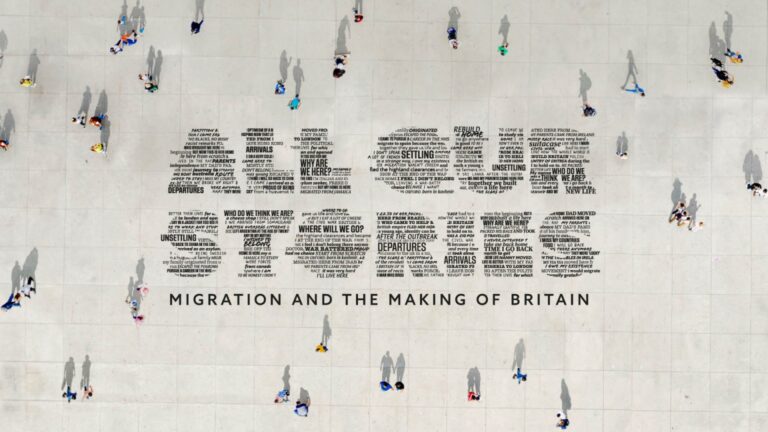
On 12 September, just weeks after the riots that shook the nation, where far-right groups made clear their feelings towards immigration and multiculturalism in Britain, the Migration Museum, located in Lewisham Shopping Centre, southeast London, launched its latest exhibition, ‘All Our Stories’.
The exhibition, which features a range of works, from immersive installations, paintings and film to photography, personal stories and keepsakes, aims to shed a light on how central migration has always been in British history and society. Shown in the exhibition, is the culmination of some of the most powerful works displayed in the museum over the past decade, alongside new artwork that explores how migration has shaped individuals and communities in the UK.
Aditi Anand, artistic director at the Migration Museum, says ‘All Our Stories’ is significant because it “shows how deeply embedded migration is into all of our lives, whether we’re migrants ourselves or our parents or grandparents are.” She says: “Even if you just live in this country, you can’t escape the fact that migration has shaped everything from the buildings in our streets to our language, the food we eat, the clothes we wear, the apps on our phones. It’s absolutely everywhere, and it’s almost hidden in plain sight. So this exhibition is a way of trying to say that we wouldn’t be who we are without migration.”
According to Aditi, the timing of the launch was particularly apt, as it came in the aftermath of the xenophobic riots in August. She says: “With the riots, you just saw how much disinformation there is, and also how there sometimes can be these simmering sentiments that exist and they can bubble up into something quite dangerous at various points in our history. I think hopefully, the museum can provide a more calm, reflective place to have conversations that aren’t full of this disinformation.”
To tackle misinformed stereotypes and presumptions about migrants, Aditi says that the exhibition acts as a space where people can “encounter human stories” and “witness people’s journeys and struggles” in a way that can “humanise the situation”. “It’s not just about the kind of alarming numbers you hear about in the media, but it’s about people. I think that connection is really important to help us all live better together.”
‘All Our Stories’ has been carefully curated by the museum’s award-winning curatorial team, who used public evaluation forms to determine the most popular pieces from the past decade. Among the notable works in the exhibition was Karen Arthur’s ‘Queen Joyce’ dress, which incorporates African ankara material with a type of skirt that enslaved women in the Caribbean wore and a Victorian pinstripe shirt – an homage to a rich West Indian heritage influenced by British and African cultures.
Other works that stood out were ‘Takeaway’, an installation of a Chinese fast food restaurant curated by author Angela Hui, inspired by her experiences growing up behind the counter of her parents’ takeaway in Wales, and ‘Departure’, a room-sized imaginary departure lounge by Japanese artist Jiro Osuga, interspersing fantastical and historical characters among the travellers waiting to board their flights.
Another masterpiece, which captures perfectly the essence of the exhibition, is the newly commissioned film illuminating 45 key migration moments throughout history by three time BAFTA nominated director, filmmaker and animator Osbert Parker. Speaking about the riots, Osbert says: “It feels like nothing has changed. It feels like history constantly repeats itself. There’s a human instinct – not just of fear – but to, horribly, not engage with other people and not be empathetic towards them. That’s been going on for years and I would’ve hoped we would have learnt through the negative reactions.”
He adds: “I really wish that the politicians would come and be at this exhibition and actually learn from some of these repeated mistakes because it is within their power to actually bring about real change.”
In a society where government and institutions fail to promote interconnectedness between different communities and cultures, the Migration Museum, which was born in an effort to “build Britain’s missing museum”, aims to bridge the gap in an increasingly divided Britain.
However, tackling misconceptions and harmful narratives around migration comes at a cost. The idea of ‘All Our Stories’ emerged shortly after the museum received planning permission for its permanent site in the City of London, a project which is projected to cost a total of £20m pounds.
So far, the museum has relied on funding from “a patchwork of trusts and foundations”, says Aditi, including core donors such as Paul Hammond Foundation and Esmée Fairbairn Foundation. However, funding remains a challenge for the museum, which is free to the public, but encourages donations. Aditi says that it’s important for the museum to be free so it can “be absolutely accessible”. She adds: “We’re in the middle of Lewisham Shopping Centre as well. It’s very much a resource for local communities as well as the wider public, and we always want to be that welcoming space where it’s absolutely for everybody.”
The exhibition will be open to the public until December 2025. The museum is free to visit, but donations from the public are encouraged.